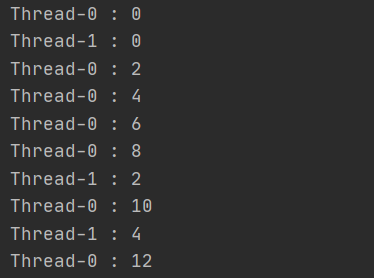Java创建多线的方式
方式一:继承Thread类
① 定义继承Thread类的子类;
② 重写run()方法,run()方法的主体即为线程体
③ 实例化继承Thread的子类的对象,即创建线程对象;
④ 通过实例对象调用start()方法启动线程
注意:想要启动多线程必须调用start()方法,通过start()方法调用run()方法,若手动调用run()方法,则不会启动多线程。
因为run()方法必须由JVM调用,至于什么时候调用,执行过程的控制都有操作系统的调度决定。
1 package com.exercise.mulTreadTest; 2 //方式1: 通过继承Thread类的方式实现多线程: 3 4 /** 5 * ① 定义继承Thread类的子类; 6 * ② 重写run()方法,run()方法的主体即为线程体 7 * ③ 实例化继承Thread的子类的对象,即创建线程对象; 8 * ④ 通过实例对象调用start()方法启动线程 9 */ 10 public class extendsThread { 11 public static void main(String[] args) { 12 myThread1 thread1 = new myThread1(); 13 thread1.start(); 14 15 myThread1 thread2 = new myThread1(); 16 thread2.start(); 17 } 18 } 19 20 class myThread1 extends Thread{ 21 @Override 22 public void run() { 23 for (int i = 0; i < 100; i++) { 24 if (i % 2 == 0){ 25 System.out.println(Thread.currentThread().getName() + " : " + i); 26 } 27 } 28 } 29 }
上述代码创建多线程的运行结果如下:可见线程1和线程2交替执行。

方式二:实现Runnable接口
① 创建一个实现Runnable接口的子类myThread;
② 重写Runnable接口中的run()方法;
③ 创建该子类myThread的对象;
④ 创建Thread类的对象,并且将子类myThread创建的对象作为Thread类含参构造器的实参
⑤ 调用start()方法启动线程
package com.exercise.mulTreadTest; /** * 方式二:实现Runnable接口 * ① 创建一个实现Runnable接口的子类myThread; * ② 重写Runnable接口中的run()方法; * ③ 创建该子类myThread的对象; * ④ 创建Thread类的对象,并且将子类myThread创建的对象作为Thread类含参构造器的实参 * ⑤ 调用start()方法启动线程 * */ public class implRunnable{ public static void main(String[] args) { myThread2 myThread2 = new myThread2(); Thread thread1 = new Thread(myThread2); Thread thread2 = new Thread(myThread2); thread1.start(); thread2.start(); } } class myThread2 implements Runnable{ @Override public void run() { for (int i = 0; i < 100; i++) { if (i % 2 == 0){ System.out.println(Thread.currentThread().getName() + " : " + i); } } } }
继承Thread类和实现Runnable接口创建多线程方式的区别:
区别:
①继承Thread类的方式重写了Thread类的run()方法并将线程代码放在里面;
②实现Runnable接口的方式重写了Runnable接口中的run()方法,线程代码存在其中。
实现Runnable接口创建多线的好处:
①避免单继承性的局限性:接口的好处
②多个接口共享同一个接口实现类的对象,非常适合多个相同线程处理同一份资源。
方式三: 实现Callable接口
①创建一个实现Callable接口的实现类;
②在实现类中重写call()方法,即线程体;
③创建实现类的实例;
④使用实现类的实例作为参数创建一个FutureTask类的实例;
⑤使用FutrueTask类的实例作为参数创建一个Thread类的实例并调用start()方法启动线程;
⑥使用FutureTask实例调用get()方法获取call()方法的返回值。
1 package com.exercise.mulTreadTest; 2 3 import java.util.concurrent.Callable; 4 import java.util.concurrent.ExecutionException; 5 import java.util.concurrent.FutureTask; 6 7 public class implCallable { 8 public static void main(String[] args) { 9 //3.创建实现类myThread3的实例 10 myThread3 myThread3 = new myThread3(); 11 //4.使用myThread3作为参数创建FutureTask类的实例 12 FutureTask futureTask = new FutureTask(myThread3); 13 //5.使用futureTask作为参数创建Thread类的实例 14 Thread thread = new Thread(futureTask); 15 //6.启动线程 16 thread.start(); 17 18 try { 19 //7.获取call()方法的返回值 20 Object o = futureTask.get(); 21 System.out.println(o); 22 23 } catch (InterruptedException e) { 24 e.printStackTrace(); 25 } catch (ExecutionException e) { 26 e.printStackTrace(); 27 } 28 29 } 30 } 31 32 //1.创建接口Callable的实现类 33 class myThread3 implements Callable { 34 //重写call()方法 35 @Override 36 public Object call() throws Exception { 37 int sum = 0; 38 for (int i = 0; i < 100; i++) { 39 sum += i; 40 } 41 return sum; 42 } 43 }
方式四: 使用线程池
1 package com.exercise.java2; 2 3 import java.util.concurrent.ExecutorService; 4 import java.util.concurrent.Executors; 5 import java.util.concurrent.ThreadPoolExecutor; 6 7 /** 8 * 创建线程的方式四:使用线程池 9 * 好处: 10 * 1.提高响应速度(减少创建线程的时间); 11 * 2.降低资源消耗(重复利用线程池中的线程,不需要每次都创建) 12 * 3.便于线程管理 13 * √ corePoolSize: 核心池的大小 14 * √ maximumPoolSize: 最大线程数 15 * √ keepAliveTime: 线程没有任务是最多保持多长时间后会终止 16 */ 17 18 class NumberThread implements Runnable{ 19 @Override 20 public void run() { 21 for (int i = 0; i < 100 ; i++) { 22 if(i % 2 == 0){ 23 System.out.println(Thread.currentThread().getName() + ":" + i); 24 } 25 } 26 } 27 } 28 29 class NumberThread1 implements Runnable{ 30 @Override 31 public void run() { 32 for (int i = 0; i < 100 ; i++) { 33 if(i % 2 == 1){ 34 System.out.println(Thread.currentThread().getName() + ":" + i); 35 } 36 } 37 } 38 } 39 40 public class ThreadPool { 41 public static void main(String[] args) { 42 //1.提供指定线程数量的线程池 43 ExecutorService executorService = Executors.newFixedThreadPool(10); 44 45 ThreadPoolExecutor service1 = (ThreadPoolExecutor)executorService; 46 47 service1.setCorePoolSize(15);; 48 //设置线程池的属性 49 System.out.println(executorService.getClass()); 50 51 //2.执行指定的线程操作.需要实现Runnable接口或Callable接口类的对象 52 executorService.execute(new NumberThread()); //适合适用于Runnable 53 executorService.execute(new NumberThread1()); 54 55 56 // executorService.submit(Callable callable); //适合使用于Callable 57 //3.关闭线程池 58 executorService.shutdown(); 59 } 60 }
本文来自博客园,作者:凸云,转载请注明原文链接:https://www.cnblogs.com/jasonXY/p/15257241.html



 浙公网安备 33010602011771号
浙公网安备 33010602011771号